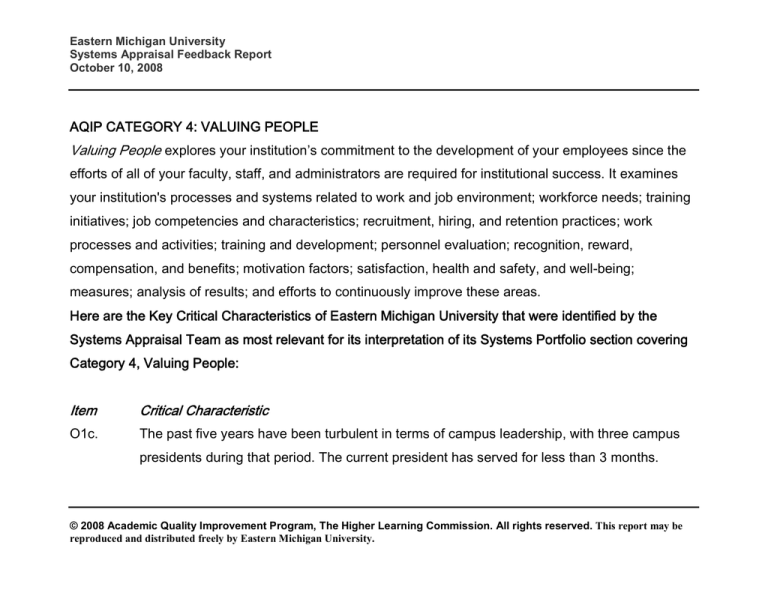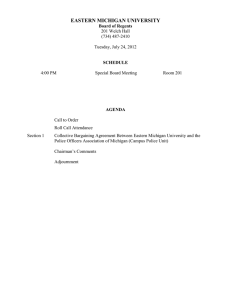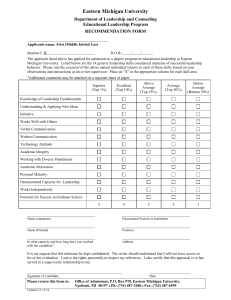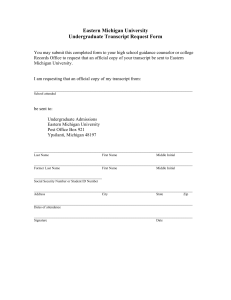
Eastern Michigan University Systems Appraisal Feedback Report October 10, 2008 AQIP CATEGORY 4: VALUING PEOPLE
Valuing People explores your institution’s commitment to the development of your employees since the
efforts of all of your faculty, staff, and administrators are required for institutional success. It examines
your institution's processes and systems related to work and job environment; workforce needs; training
initiatives; job competencies and characteristics; recruitment, hiring, and retention practices; work
processes and activities; training and development; personnel evaluation; recognition, reward,
compensation, and benefits; motivation factors; satisfaction, health and safety, and well-being;
measures; analysis of results; and efforts to continuously improve these areas.
Here are the Key Critical Characteristics of Eastern Michigan University that were identified by the
Systems Appraisal Team as most relevant for its interpretation of its Systems Portfolio section covering
Category 4, Valuing People:
Item
Critical Characteristic
O1c.
The past five years have been turbulent in terms of campus leadership, with three campus
presidents during that period. The current president has served for less than 3 months.
© 2008 Academic Quality Improvement Program, The Higher Learning Commission. All rights reserved. This report may be reproduced and distributed freely by Eastern Michigan University. Eastern Michigan University Systems Appraisal Feedback Report October 10, 2008 O1d.
Eastern Michigan University has embraced a commitment to contribute to the local
community in its core principles and strategic directions, demonstrated by more than 25,000
hours of student volunteer community service annually O1e. Eastern Michigan University is
currently engaged in a thoughtful, evidence-based approach to campus-wide planning
O1f.
Eastern Michigan University is guided by a mission that emphasizes excellence in teaching,
applied research, and artistic expression
O1g.
Eastern Michigan University has adopted five core principles and four strategic directions
that guide decision making, which emphasize learning, engagement with the community, and
diversity and multiculturalism.
O2b.
Students have an opportunity to take classes and complete programs at seven off-campus
locations through Continuing Education
O4a.
Eastern Michigan University collaborates through accreditation agencies, businesses,
centers and institutions, targeted industry grants, research grants and agreements,
nonprofits, advisory boards and steering committees, community colleges, and K-12 districts.
© 2008 Academic Quality Improvement Program, The Higher Learning Commission. All rights reserved. This report may be reproduced and distributed freely by Eastern Michigan University. Eastern Michigan University Systems Appraisal Feedback Report October 10, 2008 O5a.
Most of Eastern Michigan University’s employees are represented by unions. The nonunion
employees include administrative/professional, confidential clerical employees and coaches.
O5b.
Eastern Michigan University’s recent history includes challenging labor relations, especially
with the AAUP faculty union.
O6e.
Since a high-publicity on-campus homicide in December 2007, security has been a very high
priority. Physical upgrades and safety programs have been implemented.
O6f.
Eastern Michigan University's main campus is located southwest of the larger metropolitan
area of Detroit. The current economic conditions in southeast Michigan are negatively
affected by the downturn in the US auto industry and impact Eastern Michigan University and
the state.
Here are what the Systems Appraisal Team identified as Eastern Michigan University’s most important
strengths and opportunities for improvement relating to processes encompassed by Category 4, Valuing
People.
© 2008 Academic Quality Improvement Program, The Higher Learning Commission. All rights reserved. This report may be reproduced and distributed freely by Eastern Michigan University. Eastern Michigan University Systems Appraisal Feedback Report October 10, 2008 Item
S/O
4P1
S
Comment
Well-defined and articulated processes are in place for hiring faculty, staff, and
administrative employees. The appropriate units screen and evaluate
applications.
4P2
S
The University has clear processes for recruiting and orienting new employees.
New faculty participates in orientation programs at the University level prior to
first semester assignment and subsequently by college, department and union
orientations. Staff and administrators also participate in orientations collectively
and at the department level. Orientations stress performance expectations, pay
and benefits and the University mission. A key focus for new faculty is to help
them understand the diversity of the student body, and to prepare them to work
with those students.
4P3
S
Opportunities for shared governance of the institution exist across the board.
© 2008 Academic Quality Improvement Program, The Higher Learning Commission. All rights reserved. This report may be reproduced and distributed freely by Eastern Michigan University. Eastern Michigan University Systems Appraisal Feedback Report October 10, 2008 4P3
O
The University has a variety of councils through which operational planning and
communication are shared. Policies addressing various ethical issues have been
identified. Beyond these basic elements, as well as developing systems for
training and development, it is not clear that Eastern Michigan University has
incorporated a thorough system through which it can implement a highperformance organization with systems for continuous improvement among
employees. Innovation, cooperation, empowerment, organizational learning and
skill sharing are not evidently commonplace. The University can benefit by a
more thorough development of processes that can lead to great development
and utilization of employees’ skills and capabilities.
4P4
S
Eastern Michigan University offers a reasonable portfolio of professional
development programs for both faculty (including graduate assistants, and other
instructional staff) and staff.
4P4-4P6
O
It is unclear that the term “faculty” is always used inclusively of lecturers, part
time, and other adjunct instructors—all those who provide instruction to Eastern
Michigan University students.
© 2008 Academic Quality Improvement Program, The Higher Learning Commission. All rights reserved. This report may be reproduced and distributed freely by Eastern Michigan University. Eastern Michigan University Systems Appraisal Feedback Report October 10, 2008 4P5
S
Eastern Michigan University determines training needs through the performance
appraisal process, through both corrective and pro-active mechanisms, so
regardless if a performance gap is identified, the performance appraisal process
incorporates the identification of training and development needs.
4P6
O
The University appears to have implemented a detailed process for personnel
evaluation, which is an outgrowth of the collective bargaining agreements with
faculty and staff. These include probationary periods for new hires, annual
performance evaluations and feedback methods that identify strengths and
weaknesses of employees. Mechanisms for correcting deficiencies in
performance are also in place. While these are important and valuable
processes, it will be important that the University develop additional methods by
which employees, especially post-probationary employees, can be encouraged
to go beyond meeting minimum requirements and seek out ways to continuously
improve their skills and processes. An important dimension of this is enhanced
attention to improvements in the teaching-and-learning process.
© 2008 Academic Quality Improvement Program, The Higher Learning Commission. All rights reserved. This report may be reproduced and distributed freely by Eastern Michigan University. Eastern Michigan University Systems Appraisal Feedback Report October 10, 2008 4P7-4P8
OO
Processes for recognition and reward appear to be incorporated into the
collective bargaining processes, aside from a few awards for exemplary
contributions in teaching, scholarship, service and student affairs. As such, there
are currently few mechanisms to motivate employees for continuous
improvement. It is unclear whether the existing processes can foster a culture of
high-performance and ongoing professional growth and development. While
levels of employee security are important and can be supported through
collective bargaining agreements, the University should also explore ways by
which employees can be encouraged to surpass standardized employee
expectations in pursuit of the mission’s commitment to teaching and learning.
4P8
O
No plan for determining key motivational issues is identified.
4P9
O
No plan for evaluating employee satisfaction, health and safety, and wellbeing is
identified.
4P10
O
Eastern Michigan University’s methods for collecting and analyzing measures of
valuing people appear limited in scope. Current measures are indirect indicators
of the extent to which employees perceive they are valued. Aside from employee
© 2008 Academic Quality Improvement Program, The Higher Learning Commission. All rights reserved. This report may be reproduced and distributed freely by Eastern Michigan University. Eastern Michigan University Systems Appraisal Feedback Report October 10, 2008 retention and years of service, few mechanisms to addresses processes for
valuing people are in place.
4R1
O
While Eastern Michigan University provides some data related to turnover and
length of employee service at the institution, it is difficult to provide feedback
without trend (several years) or comparative data to assess and analyze the
results.
4R2
S
Eastern Michigan University administered a national employee survey to obtain a
baseline for developing and improving targets. Eastern Michigan University plans
to continue to revise and evaluate the existing tool for staff evaluation.
4R3
O
Some indicators of employee productivity are given, but without comparison to
peer institutions, it is not possible to determine the extent of success in this area.
4R4
O
No benchmarking comparisons available at this time. Without such comparisons,
it is difficult to judge the extent of success in this area.
4I1
S
Mid- and upper-level management have a professional training program
dedicated to their particular needs.
4I2
O
No target setting for improvements presented for stakeholder groups are
identified.
© 2008 Academic Quality Improvement Program, The Higher Learning Commission. All rights reserved. This report may be reproduced and distributed freely by Eastern Michigan University.



